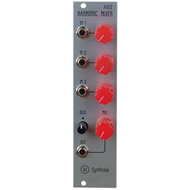AI022 Harmonic Mixer - AI Synthesis
by Jason Czyeryk
I’m starting to think of AI Synthesis’ modules like you would sequels to movies; James Bond movies to be specific. No doubt, this is because of their sequential numbers, and I believe their 22nd installment would have a name like No Time to Mix, or From My Harmonic Mixer with Love, but that’s not how it is, and AI Synthesis is all business…AI022, Harmonic Mixer it is.
A discrete mixer in the style of Moog’s revered CP3 mixer AI022 seems simple enough, consisting of three input channels with attenuation control [these are passive], a bias control, and a main mix output. Since the inputs are passive, it may behave in ways you’re not used to as there’s crosstalk between the inputs and the overall output is unable to be amplified, with the ceiling’s level determined by the input with the highest level. These traits are typical of a CP3 inspired mixer, and some of the things that make give it the quirks that are sought after.
In the AI022 you can run either a CV or audio signal into an input, and mix away. The thing with this, is that it’s not just a normal mixer, it’s a harmonic mixer so that with increases in gain, harmonics are added to the signal, warming it up, and if you increase the gain enough, you get all sorts of waveformy goodness in the form of distortion and phasing. Basically, whatever waveforms you put it, if AI022 is pushed enough, will be unrecognizable at the output. This is a good thing. Factor in the crosstalk and you’ve got a potentially unpredictable mixer with a lot of possibilities, one that you can dial in a unique sound on, and may never see or hear it again.
Being able to bias the signal allows for more overall manipulation in various ways, add offset to CV signals, and it seems like this is the card up AI022’s sleeve as on the original Moog circuit you’d have to mod it to be able to mess with it from the front panel.
In practice, by rocking the various level controls you can add distortion, harmonics, and grit from varying sound sources. I found myself using the first channel as a sort of main channel, and then playing channels 2 and 3, mixing them in as desired, to effect channel 1’s output. In that way, while I was obviously “mixing” I found it helpful to think of AI022 as an adder of sorts instead of a mixer. I think my brain is just stuck in the mud thinking of a mixer as an end of chain, or end of bus type of thing, instead of part of the creative component of shaping sound.
With the Joranalogue Generate 3’s full output being pitch-controlled by the Waveform 1U ribbon and going into the Strymon Starlab, I would simultaneously increase the pitch and the level of this short patch into channel 2 of AI022 and mix it with my main signal, patched into channel 1, which was being a sequenced triangle wave of a three-note repetitive melody. I did this while using a sine wave LFO in channel 3 to give it some more movement and the performative qualities of AI022 became apparent. There was definitely a lack of control going on, but it was fun and blew out the sound in a pleasing way.
Of course, you could just use AI022 to fatten up your sound, and in fact, many claim that a large part of the beloved Moog sound is due to the VCOs overloading the mixer. There is a pretty steep falling off point with the overload, and I found that after a certain point the harmonic additions would turn into distortion—not completely surprising—as if a switch was flipped, but it is possible, with the exact same input signals, to have so many variations of a sound just by adjusting the levels any which way.
In summation, the AI022 is a cool little mixer. It’s part utility and part effect, and if you’re not used to having a mixer that can add to your sound in this fashion, it’s time to be in on the secret.
6HP +12v 9mA -12v 9mA
Price: $15-$85


